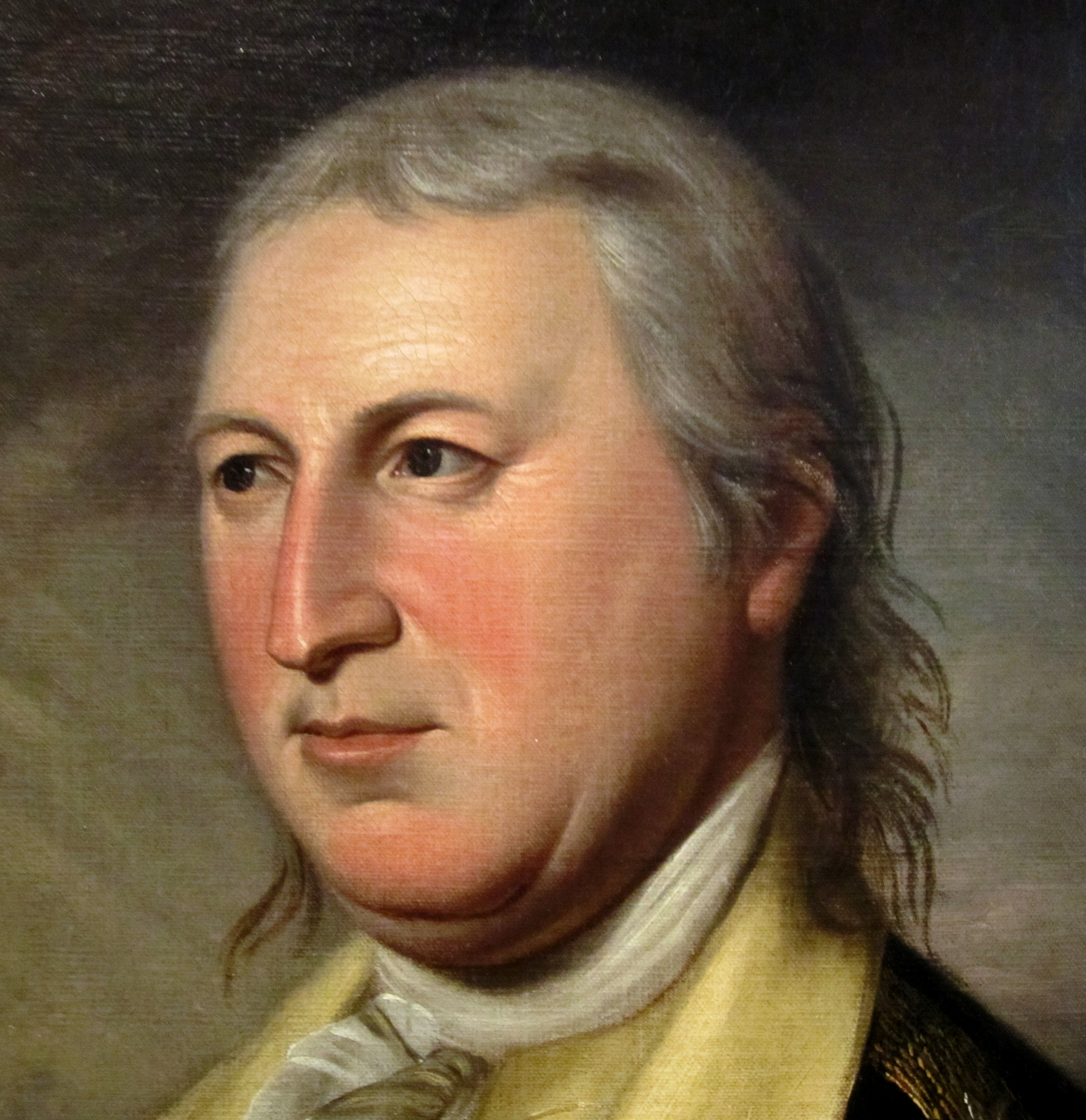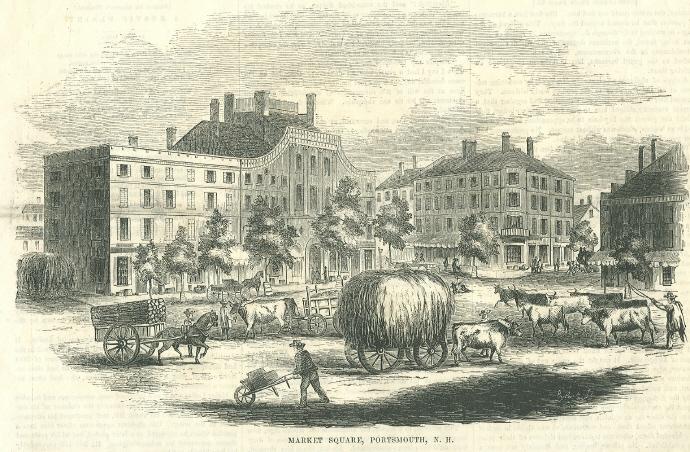|
Enoch Poor
Enoch Poor (June 21, 1736 (Old Style) – September 8, 1780) was a brigadier general in the Continental Army during the American Revolutionary War. He was a ship builder and merchant from Exeter, New Hampshire. Biography Poor was born and raised in Andover, Massachusetts. His father Thomas Poor had been part of the 1745 expedition that captured Louisburg, Nova Scotia, during King George's War. In 1755, Poor enlisted as a private in one of the Massachusetts units raised to accompany Jeffery Amherst's expedition to retake Louisburg during the French and Indian War. His unit enforced the expulsion of the Acadians. After the war, he came home to Andover, but only briefly. He eloped with Martha Osgood, and they settled in Exeter where he became a successful ship builder. Poor supported the separatists as early as the Stamp Act protests in 1765. He served on various committees for Exeter throughout the period of rising rebellion. In 1775, he was twice elected to the provincial Assembl ... [...More Info...] [...Related Items...] OR: [Wikipedia] [Google] [Baidu] |
Tadeusz Kościuszko
Andrzej Tadeusz Bonawentura Kościuszko ( be, Andréj Tadévuš Banavientúra Kasciúška, en, Andrew Thaddeus Bonaventure Kosciuszko; 4 or 12 February 174615 October 1817) was a Polish Military engineering, military engineer, statesman, and military leader who became a national hero in Belarus, France, Lithuania, Poland and the United States. He fought in the Polish–Lithuanian Commonwealth's struggles against Russian Empire, Russia and Kingdom of Prussia, Prussia, and on the US side in the American Revolutionary War. As Supreme Commander of the Polish National Armed Forces, he led the 1794 Kościuszko Uprising. Kościuszko was born in February 1746, in a manor house on the Mieračoŭščyna, Mereczowszczyzna estate in Brest Litovsk Voivodeship, then Grand Duchy of Lithuania, a part of the Polish–Lithuanian Commonwealth (now Ivatsevichy District of Belarus). At age 20, he graduated from the Corps of Cadets (Warsaw), Corps of Cadets in Warsaw, Poland. After the start of t ... [...More Info...] [...Related Items...] OR: [Wikipedia] [Google] [Baidu] |
2nd New Hampshire Regiment
The 2nd New Hampshire Regiment was formed in early May 1775, as the second of three Continental Army regiments raised by the state of New Hampshire during the American Revolutionary War. Its first commander was Colonel Enoch Poor, with Joseph Cilley as major. Many of the men who served in the unit hailed from southeastern New Hampshire and western Maine (then part of Massachusetts). During the first part of its service, the regiment took part in the siege of Boston, and there is a link below in the reference section to the orderly book of an officer in the unit during that time. History 1776 In 1776, the 2nd New Hampshire also became known as the 8th Continental Regiment, though that designation would revert to the 2nd NH by the end of that year. After the capture of Boston in March, the 2nd New Hampshire saw action at the Battle of Trois-Rivières in Quebec, and by July 1776 they had retreated south to Fort Ticonderoga and helped construct a new fort across Lake Champlain on Ra ... [...More Info...] [...Related Items...] OR: [Wikipedia] [Google] [Baidu] |
Horatio Gates
Horatio Lloyd Gates (July 26, 1727April 10, 1806) was a British-born American army officer who served as a general in the Continental Army during the early years of the Revolutionary War. He took credit for the American victory in the Battles of Saratoga (1777) – a matter of contemporary and historical controversy – and was blamed for the defeat at the Battle of Camden in 1780. Gates has been described as "one of the Revolution's most controversial military figures" because of his role in the Conway Cabal, which attempted to discredit and replace General George Washington; the battle at Saratoga; and his actions during and after his defeat at Camden.Bilias, p. 80 Born in the town of Maldon in Essex, Gates served in the British Army during the War of the Austrian Succession and the French and Indian War. Frustrated by his inability to advance in the army, Gates sold his commission and established a small plantation in Virginia. On Washington's recommendation, the Continen ... [...More Info...] [...Related Items...] OR: [Wikipedia] [Google] [Baidu] |
Arthur St
Arthur is a common male given name of Brythonic origin. Its popularity derives from it being the name of the legendary hero King Arthur. The etymology is disputed. It may derive from the Celtic ''Artos'' meaning “Bear”. Another theory, more widely believed, is that the name is derived from the Roman clan '' Artorius'' who lived in Roman Britain for centuries. A common spelling variant used in many Slavic, Romance, and Germanic languages is Artur. In Spanish and Italian it is Arturo. Etymology The earliest datable attestation of the name Arthur is in the early 9th century Welsh-Latin text '' Historia Brittonum'', where it refers to a circa 5th to 6th-century Briton general who fought against the invading Saxons, and who later gave rise to the famous King Arthur of medieval legend and literature. A possible earlier mention of the same man is to be found in the epic Welsh poem '' Y Gododdin'' by Aneirin, which some scholars assign to the late 6th century, though this is still a ... [...More Info...] [...Related Items...] OR: [Wikipedia] [Google] [Baidu] |
Continental Congress
The Continental Congress was a series of legislative bodies, with some executive function, for thirteen of Britain's colonies in North America, and the newly declared United States just before, during, and after the American Revolutionary War. The term "Continental Congress" most specifically refers to the First and Second Congresses of 1774–1781 and, at the time, was also used to refer to the Congress of the Confederation of 1781–1789, which operated as the first national government of the United States until being replaced under the Constitution of the United States. Thus, the term covers the three congressional bodies of the Thirteen Colonies and the new United States that met between 1774 and 1789. The First Continental Congress was called in 1774 in response to growing tensions between the colonies culminating in the passage of the Intolerable Acts by the British Parliament. It met for about six weeks and sought to repair the fraying relationship between Britain and t ... [...More Info...] [...Related Items...] OR: [Wikipedia] [Google] [Baidu] |
Morristown, New Jersey
Morristown () is a town and the county seat of Morris County, in the U.S. state of New Jersey.New Jersey County Map New Jersey Department of State. Accessed July 10, 2017. Morristown has been called "the military capital of the " because of its strategic role in the war for independence from Great Britain. Today this history is visible in a variety of locations throughout the town that collectively make up |
Fort Ticonderoga
Fort Ticonderoga (), formerly Fort Carillon, is a large 18th-century star fort built by the French at a narrows near the south end of Lake Champlain, in northern New York, in the United States. It was constructed by Canadian-born French military engineer Michel Chartier de Lotbinière, Marquis de Lotbinière between October 1755 and 1757, during the action in the "North American theater" of the Seven Years' War, often referred to in the US as the French and Indian War. The fort was of strategic importance during the 18th-century colonial conflicts between Great Britain and France, and again played an important role during the Revolutionary War. The site controlled a river portage alongside the mouth of the rapids-infested La Chute River, in the between Lake Champlain and Lake George. It was thus strategically placed for the competition over trade routes between the British-controlled Hudson River Valley and the French-controlled Saint Lawrence River Valley. The terrain ... [...More Info...] [...Related Items...] OR: [Wikipedia] [Google] [Baidu] |
Invasion Of Canada (1775)
The Invasion of Quebec (June 1775 – October 1776, french: Invasion du Québec) was the first major military initiative by the newly formed Continental Army during the American Revolutionary War. The objective of the campaign was to seize the Province of Quebec (part of modern-day Canada) from Great Britain, and persuade French-speaking to join the revolution on the side of the Thirteen Colonies. One expedition left Fort Ticonderoga under Richard Montgomery, besieged and captured Fort St. Johns, and very nearly captured British General Guy Carleton when taking Montreal. The other expedition, under Benedict Arnold, left Cambridge, Massachusetts and traveled with great difficulty through the wilderness of Maine to Quebec City. The two forces joined there, but they were defeated at the Battle of Quebec in December 1775. Montgomery's expedition set out from Fort Ticonderoga in late August, and in mid-September began besieging Fort St. Johns, the main defensive point south o ... [...More Info...] [...Related Items...] OR: [Wikipedia] [Google] [Baidu] |
Richard Montgomery
Richard Montgomery (2 December 1738 – 31 December 1775) was an Irish soldier who first served in the British Army. He later became a major general in the Continental Army during the American Revolutionary War, and he is most famous for leading the unsuccessful 1775 invasion of Quebec. Montgomery was born and raised in Ireland. In 1754, he enrolled at Trinity College, Dublin, and two years later joined the British Army to fight in the French and Indian War. He steadily rose through the ranks, serving in North America and then the Caribbean. After the war he was stationed at Fort Detroit during Pontiac's War, following which he returned to Britain for health reasons. In 1773, Montgomery returned to the Thirteen Colonies, married Janet Livingston, and began farming. When the American Revolutionary War broke out, Montgomery took up the Patriot cause, and was elected to the New York Provincial Congress in May 1775. In June 1775, he was commissioned as a brigadier genera ... [...More Info...] [...Related Items...] OR: [Wikipedia] [Google] [Baidu] |
Battle Of Bunker Hill
The Battle of Bunker Hill was fought on June 17, 1775, during the Siege of Boston in the first stage of the American Revolutionary War. The battle is named after Bunker Hill in Charlestown, Massachusetts, which was peripherally involved in the battle. It was the original objective of both the colonial and British troops, though the majority of combat took place on the adjacent hill which later became known as Breed's Hill. On June 13, 1775, the leaders of the colonial forces besieging Boston learned that the British were planning to send troops out from the city to fortify the unoccupied hills surrounding the city, which would give them control of Boston Harbor. In response, 1,200 colonial troops under the command of William Prescott stealthily occupied Bunker Hill and Breed's Hill. During the night, the colonists constructed a strong redoubt on Breed's Hill, as well as smaller fortified lines across the Charlestown Peninsula. By daybreak of June 17, the British became a ... [...More Info...] [...Related Items...] OR: [Wikipedia] [Google] [Baidu] |
Portsmouth, New Hampshire
Portsmouth is a city in Rockingham County, New Hampshire, United States. At the 2020 census it had a population of 21,956. A historic seaport and popular summer tourist destination on the Piscataqua River bordering the state of Maine, Portsmouth was formerly the home of the Strategic Air Command's Pease Air Force Base, since converted to Portsmouth International Airport at Pease. History American Indians of the Abenaki and other Algonquian languages-speaking nations, and their predecessors, inhabited the territory of coastal New Hampshire for thousands of years before European contact. The first known European to explore and write about the area was Martin Pring in 1603. The Piscataqua River is a tidal estuary with a swift current, but forms a good natural harbor. The west bank of the harbor was settled by European colonists in 1630 and named Strawbery Banke, after the many wild strawberries growing there. The village was protected by Fort William and Mary on what is now ... [...More Info...] [...Related Items...] OR: [Wikipedia] [Google] [Baidu] |





